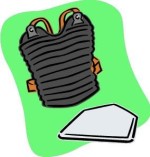Home Plate Umpiring Advanced Techniques
Besides calling the game, what are my other responsibilities?
The short answer: Most often you will be viewed as the "Umpire in Chief" for that game, providing overall game management and the final word on questions relating to rules.
Lead the pregame meetings with scorekeeper, fellow umpires and managers
- Prior to each game, confirm who will be the official scorekeeper. The scorekeeper will be the single, go-to source for any questions such as batting order, current batter count, number of outs, runs scored and other questions during the game.
- Meet with the base umpires to agree on how the field and runners will be covered by each umpire, who will call fair/foul and catch/no-catch situations.
- Meet with both managers and your umpire crew as a group right before the first pitch to introduce one another and review topics related to the game to minimize misunderstandings during the game. Topics include:
- exchange of line-up cards
- confirmation of official scorekeeper and role
- time limits (if any) for the game
- special field considerations such as out-of-play areas
- the protocol for how managers should request time
- the protocol for how managers should request review of umpire calls (if any).
Manage the overall flow of the game
- As you gain experience you'll develop different techniques for moving the game along swiftly and reducing wasted time. Some examples:
- enforce time limit for pitcher warm-ups to 8 pitches or 60 seconds (whichever comes first)
- prompt batters into the box if they are moving slowly
- remind coaches to send a warm-up catcher between innings if the catcher is delayed in getting his gear on.
Enforce the rules
- There will be times when you'll be asked about potential rule violations and penalties, often under a coach's challenge and in the heat of battle. Understanding, applying and explaining the numerous rules takes experience.
- Read what you can from the Little League Rule Book and attend training sessions that your local Little League offers. Most importantly, try to work games with and learn from a veteran umpire in your first few seasons of umpiring. You'll be amazed at the value of knowing just a few rules well versus the vast number of rule situations that rarely occur (if at all).
Back up the base umpires (when you can)
- Observe runner out/safe calls and base path activity when you can and where you (as the Plate Umpire) have an advantageous angle on the play. For example, you could be looking down the 1st baseline for a pulled foot by the 1st baseman or for a tag on the backside of a runner that is not visible to the Base Umpire. In these cases, the Base Umpire still owns making the call but can opt to consult with you after the play.
Next up: What are the main differences between plate umpiring baseball and softball?



